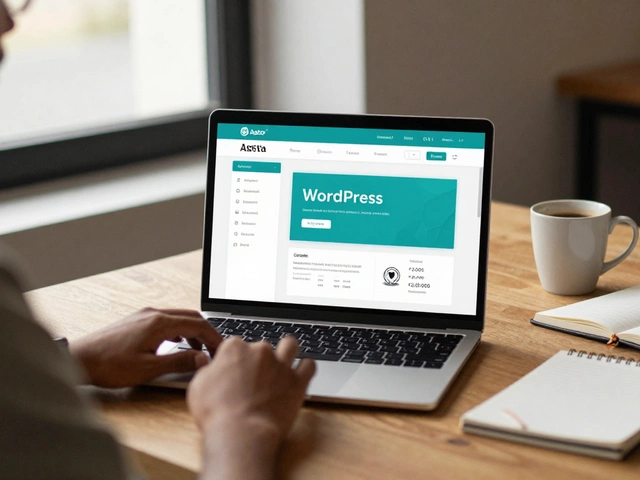Think the .in domain is just for people or businesses in India? That's a common guess, but it's not the full story. You don't need an Indian passport or even an Indian address to grab a .in website. The rules changed years ago to make the .in domain way more accessible.
So, if you're running a blog from London, selling to techies in Bangalore, or just want a super short, punchy domain, .in might be on your radar. But before you register one, you should know what makes .in different from the crowd, how easy it is to get, and what you should watch for if you pick it as your main site address. This is especially key if you're thinking about Indian website hosting, or hoping to reach customers in Asia’s fastest growing internet market.
- What Is the .in Domain?
- Who Can Register a .in Domain?
- Why Use a .in Domain (Even If You're Not in India)?
- Things to Watch Out For with .in Domains
What Is the .in Domain?
The .in domain is the official country code top-level domain (ccTLD) for India. If you’ve ever clicked a site ending with .in, you’ve landed on an address that’s supposed to have some link to India. Kind of like .uk for the UK or .ca for Canada, but with a few unique twists. Unlike some ccTLDs that stick to strict residency rules, the .in extension is actually open for anyone across the globe. This has made it pop up everywhere, from Indian e-commerce portals to trendy tech startups worldwide.
Launched in 1989, the domain was tightly restricted for years. Only Indian companies or state-run bodies could use it. But by 2005, the rules got way looser. The National Internet Exchange of India (NIXI) is in charge now, and registering a .in domain is pretty straightforward. You just need basic details and a valid payment method, no need to show proof of residency or business in India. That’s one big reason its numbers have shot up quickly over the past decade.
Here’s a quick data snapshot showing how the .in domain stacks up now:
| Year | Registered .in Domains |
|---|---|
| 2005 | 100,000+ |
| 2010 | 600,000+ |
| 2020 | 2,400,000+ |
| 2024 | 3,300,000+ |
It’s now the third most popular country code domain in Asia, after .cn (China) and .jp (Japan). So if you see .in domain pop up, know that it’s recognized all over the world—sometimes as a nod to India, and sometimes just because it’s short, catchy, and easy to remember. Plus, the price for registration is usually on par with classic domains like .com or .net, and most well-known registrars offer it in their standard catalog.
If you’re thinking of websites that offer real-time .in checks or hosting with .in domains, you’ll find hundreds, including big names like GoDaddy, Namecheap, and Indian providers like BigRock. There aren’t major hoops to jump through. Just pick your name, check if it’s taken, and you’re in business. That simplicity is a big part of why .in has taken off with not just Indians, but businesses and individuals everywhere.
Who Can Register a .in Domain?
Here's the cool part: just about anyone can register a .in domain. You don’t have to prove you live in India, run an Indian company, or jump through any kind of citizenship hoops. The official registry—INRegistry under NIXI (National Internet Exchange of India)—opened the doors wide in 2005. That move made it easy for individuals, startups, bloggers, and global brands to grab a .in name.
You're set to claim a .in domain if you fit any of these groups:
- Individuals anywhere in the world
- Businesses, no matter where you're based
- Non-profits, schools, or any legal entity
- Even folks who just want a domain that looks unique or local
You don’t need to show local proof, deal with tricky paperwork, or pay extra just because you don’t live in India. Most domain registrars make registering a .in site as smooth as buying a .com or .net. Just type in your info, pay, and it’s yours—usually with instant set-up.
One thing to keep in mind: there are a few .in extensions that are restricted, like .gov.in (for Indian government) or .ac.in (for educational institutions in India). Regular folks and businesses will mostly use the standard .in, and there’s no extra red tape for that.

Why Use a .in Domain (Even If You're Not in India)?
Here’s a surprise—anyone can register a .in domain, not just people or companies with a base in India. The Indian government relaxed the rules years ago. Now, there’s zero residency requirement, so you don’t need to have an address in Mumbai, Delhi, or anywhere near India to grab a .in web address.
If you want to break into the Indian market or attract Indian website traffic, a .in domain can be a smart move. People in India trust websites ending in .in, and research shows local domains tend to get more clicks from locals. That means your site could show up higher in search results for Indian users—that’s a big SEO bonus.
But there’s another angle. Plenty of businesses use .in domains for clever branding reasons. For example, words like "log.in", "stand.in", or "plug.in" make memorable web addresses. Tons of tech firms and startups jump on this trend because it’s catchy, short, and easy to remember.
Here are some reasons why someone outside India might want a .in domain:
- Targeting India’s huge online audience—about 900 million internet users as of 2024.
- Better .in domain SEO and more local trust among Indian shoppers.
- Creative domain hacks that are easy to brand and share.
- Many popular .com addresses are gone, but .in options are still wide open.
The costs for .in registration are usually pretty low, and you won’t run into complicated paperwork or any language barriers if you sign up through a trusted domain registrar. Just make sure to check that your hosting provider supports .in domains and has good speeds for Indian visitors.
Things to Watch Out For with .in Domains
Getting your hands on a .in domain is pretty easy, but you need to know what you're getting into. While anyone can register, there are some quirks with this domain extension that are good to know before you go all in.
First off, INRegistry (the official body behind .in domains) has a pretty strict policy about what kind of content you can put on your site. Sites with illegal, counterfeit, or fake content can get taken down fast. This isn’t just talk—they take action, and there’s less wriggle room compared to some other domain extensions.
Also, privacy isn’t as tight as it is with a lot of other ccTLDs. Whois details for .in domains are sometimes more visible to the public, so if you care about keeping your info hidden, you might need to use a registrar that specifically offers privacy protection for .in. Not every provider does.
Renewals can trip people up, too. Unlike .com domains, which usually give you a 30-day grace period, .in domains often only give you 15 days. If you miss that window, your site can go offline, and someone else might grab your address fast. Here’s a quick comparison of renewal windows:
| Domain Extension | Grace Period (days) |
|---|---|
| .in | 15 |
| .com | 30 |
| .co.uk | 30 |
Another thing—search engines generally treat .in as geo-targeted to India. That’s good if you want Indian visitors, but might make it a bit harder to rank high outside India unless you really work on your SEO game. If your business is global, consider this when picking .in.
Watch out for counterfeiters, too. Because .in is open to anyone, scammers sometimes buy domains for phishing. If your brand is valuable, think about registering related .in domains so nobody else does it first.
- Always renew your .in domain on time to avoid losing it.
- Ask your hosting provider about privacy protection options.
- Monitor your website for suspicious activity to avoid domain suspension.
- If you’re targeting users outside India, double-check your SEO setup.
By keeping these things in mind, you can use a .in domain with confidence and avoid nasty surprises down the line.



